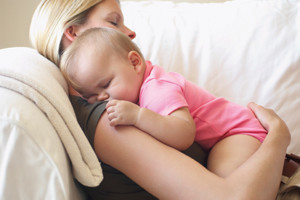Eight tips for better sleep and a happy baby

It’s 4 a.m. You're awake. Your partner is awake. And your 3-month-old is crying. What do you do?
Some parents may immediately soothe or nurse their babies back to sleep (widely known as “attachment parenting”). Others let them “cry-it-out," giving the baby the opportunity to self-soothe (known as sleep training).
Research has shown that no one method is best for a baby’s health, according to the American Academy of Sleep Medicine. Every family is different, and whether you choose attachment parenting, the cry-it-out method or take no action at all, you should feel confident that your baby will grow, and will be happy and healthy.
Practical tips for sleep training success and smooth transition to better sleep for the whole family:
1. Don’t start too early
Don’t worry about sleep or nap schedules in the first two months. Night waking is very common for babies. Research suggests that babies do not truly develop patterns and routines for sleep until around three months.
2. Establish a game plan
Your baby’s two-month checkup with the pediatrician is a good time to start thinking about how you would like to approach their sleep habits. Between the two-month and four-month checkups, observe your baby, note your own sleep habits and needs, do your research and come to an agreement with your partner on how you will proceed.
3. No matter your method, be consistent
Whatever method you use to handle night waking, stick with it, and be proactive and very clear with your goals. Consistency is key. Avoid switching back and forth from comforting the baby to letting her cry-it-out. Your baby will learn the routine faster if it is uninterrupted.
If you choose sleep training, try not to get discouraged by a few nights of little or no sleep; in most cases, it will get better after that — so hang in there. Also, don’t get distracted with the thought that they are “starving” or “feeling abandoned.” Research shows that this is not the case.
4. Resolve challenges early, rather than fix later
Changing a baby’s sleeping habits gets harder as they age. Sleep training should ideally start between three and five months.
If something about your routine (such as the time you put your baby to bed) isn’t working for you or your baby, make small adjustments until you find the right fit. If you are not having success with your method, try a more gradual approach, talk to your pediatrician and develop a new routine as soon as possible.
5. Control where your baby falls asleep
Limit the times and occasions when your baby falls asleep outside their crib or bed. If they are getting sleepy in the car seat, on your shoulder, while breast feeding or in a swing, gently transfer them to the crib or bed while they are still awake. This will encourage them to fall asleep in the right place.
6. Know your limits, and your baby’s
While consistency during sleep training is important, sometimes the rules do not apply, like when your baby is sick or teething. They may need more comforting during the night at these times, and their sleep schedule will have to resume when they feel better. If possible, try not to stray from the schedule for more than three days at a time.
7. Remember that relapses happen
Once your baby is sleeping independently, don’t be discouraged or surprised if their habits occasionally revert back. Around eight to nine months of age, babies are naturally fussy at night due to teething, growth spurts and being on the brink of gross motor skill advances (like standing or pull-ups). If their schedule gets thrown off, just start the training process again with your regular routine.
8. Maintain your routine when traveling
So when you travel, go prepared. Try to keep the same time schedule and go through all the same motions that you would at home. Bring a blanket, a stuffed animal or toy that they sleep with every night at home. This item should only come out at bedtime. That way they know it's time for bed as usual.
By Tracy Hernandez | Published April 29, 2014

